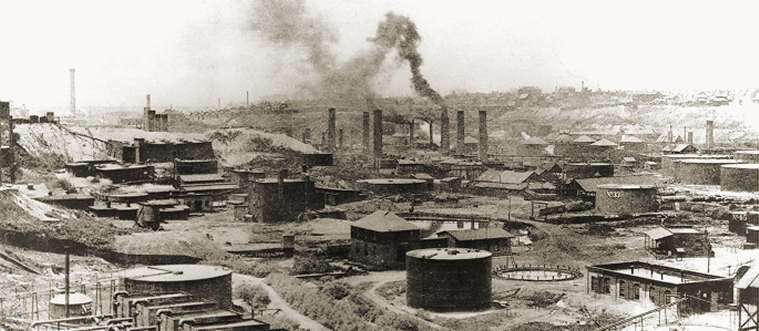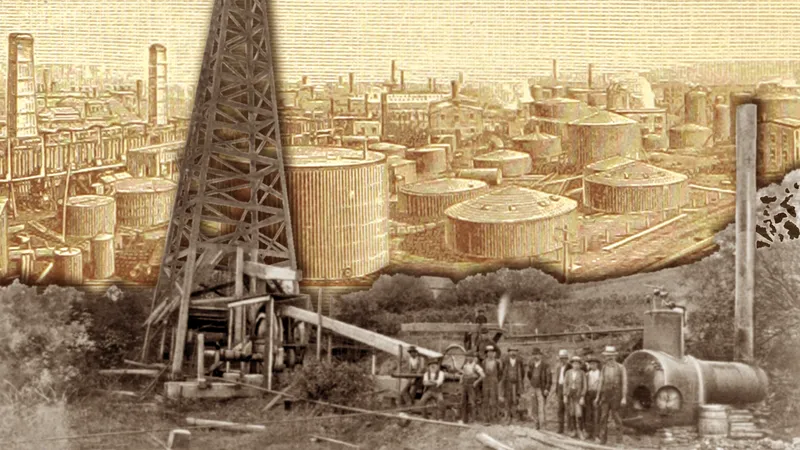History of Saudi Arabia Oil Company,On March 3, 1938, an American-owned oil well in Dhahran, Saudi Arabia, drilledĀ into what would soon be identified as the largest source ofĀ petroleumĀ in the world. The discoveryĀ radicallyĀ changed the physical, human, and politicalĀ geographyĀ of Saudi Arabia, theĀ Middle East, and the world. Before the discovery (made by the company that would eventually become Chevron), Saudi Arabians were largelyĀ nomadic. The countryāsĀ economyĀ was based onĀ tourismĀ revenueĀ fromĀ observantĀ MuslimsāĀ pilgrimagesĀ to theĀ holyĀ city of Mecca. After the discovery, SaudisĀ establishedĀ strongĀ infrastructureĀ dotted with wells, pipelines, refineries, andĀ ports. Today, oil accounts for roughly 92% of the Saudi budget. Saudi Arabia is one of the largest producers andĀ exportersĀ of oil in the world. TheĀ lucrativeĀ petroleumĀ tradeĀ fosteredĀ sophisticatedĀ diplomatic relationsĀ between Saudi Arabia and the West, as well as Japan, China, and Southeast Asia. MostĀ industrializedĀ nations depend onĀ petroleumĀ imports, and critics claim this allows Saudi Arabia to have anĀ outsizedĀ role in someĀ foreign policyĀ decisions, especially those surrounding theĀ Middle East. The discovery of oil also changed theĀ demographicsĀ of theĀ kingdom. Today, millions of foreign workersāfrom the U.S., India, Pakistan, Ethiopia, and theĀ Middle Eastālive and work in Saudi Arabia.

In 1933, Standard Oil of CaliforniaĀ (SoCal) was awarded an oil concession for the province of Al-Hasa in Saudi Arabia. Exploration commenced in the autumn but, as its geologists surveyed the terrain by motor car and aeroplane, the amount of information they could obtain about the geological substructure was limited.Ā
Traditionally,Ā geologistsĀ had relied onĀ surfaceĀ pointersĀ in the search for oil, such as; anticlines, exposed rock formations and seepages, but these features were largelyĀ absentĀ from the desert wastes.Ā
New methods such as seismic and gravity/magnetic surveys enhanced exploration, but it was the introduction ofĀ structureĀ drillingĀ that made the greatest difference at this stage. This entailed drilling shallow holes in order to determine the underlying geological structure, a technique that had been used elsewhere but never before in Saudi Arabia.
One American geologist,Ā Max Steineke, played a leading part in introducing this technique to the area, just as hopes were fading of ever finding any oil on the Arabian mainland.
Modern Technique of Structure Drilling

Whereas earlier drills had bored holes through a succession of blows, diamond drills allowed the rock core to remain intact. A barrel was screwed on to the bottom of the drill stem and then closed after drilling so that a core could be extracted.Ā Royal Dutch ShellĀ had applied this technique in the East Indies, used a double barrel in Holland and then brought it to California. Other designs were introduced, but, no matter what type of device, the objective was the same: to produce rock cores that could be examined by geologists in the field and by analysts in the laboratory. In 1922, E.W. Marland used diamond core drills to outline the northern extension and limits of an oilfield at Tonkawa, Oklahoma, and his success brought their widespread use across the industry.
In the 1920s, when even a basic steam-powered exploration rig could take a week to erect, a new type of portable rotary rig was used. Carried on a truck, it drew its power from the truckās engine or from a separate tractor engine mounted on the vehicle. These mobile rigs could drill ten 50 ft (15m) holes in a day, and were used for obtaining cores and planting explosives in the ground. In this way, the modern technique of structure drilling evolved.
Max Steineke & Structure Drilling in Arabia

While it was widely known, structure drilling had never been attempted in Arabia. In the course of his earlier career with SoCal, Steineke had worked at home and abroad, so was familiar with the technique. In 1936, when he was appointed chief geologist for theĀ California-Arabian Standard Oil Company (Casoc), which operated the Hasa concession, Steineke suggested a programme of structural drilling to map the subsurface geology and gather information about the pre-Neogene. This began later in the year with small portable rigs being introduced to the al-Qatif al-āAlah area.
These rigs drilled holes of small diameter and a few hundred feet deep in order to determine from one point to another the depth and elevation of important subsurface strata. A few holes were then sunk to greater depth in order to determine whether the rocks in certain areas were favourable to oil accumulation. Seismic data, ground surveys and, later, gravity-magnetic surveys, were used, but structure drilling was tailor-made for Saudi geology, because of the regional uniformity and continuity in rock units and their fauna.
Early Exploration Discoveries in Saudi Arabia
 A drilling rig in the Rub al-Khali, circa 1955. Ā©Evans/Stringer.In 1938, exploration was spurred on by the discovery of commercial oil at Dammam. A new intake of geologists arrived from the United States. Among them wasĀ Nestor Sander, whose duties included logging and mapping the sequence of the Eocene at a place known as Abqaiq ā āFather of Sand Fliesā ā south-west of the Dammam dome.
A drilling rig in the Rub al-Khali, circa 1955. Ā©Evans/Stringer.In 1938, exploration was spurred on by the discovery of commercial oil at Dammam. A new intake of geologists arrived from the United States. Among them wasĀ Nestor Sander, whose duties included logging and mapping the sequence of the Eocene at a place known as Abqaiq ā āFather of Sand Fliesā ā south-west of the Dammam dome.
AbqaiqĀ was Steinekeās hunch. Since there were few surface features such as salt flats, Tertiary outcrops and the alignment of dunes to suggest underground structure, it was hoped structure drilling would provide more clues about the substructure. In his articleĀ Early Exploration: The Structure Drill,Ā Sander described how the subsequent programme of structural drilling proceeded around Abqaiq. After placing the first well, S-8, in the sabkha to the east, he sited the next one on what he believed was the axis of the north-south trending anticlinal feature. Three fossils were used as markers, with drilling ceasing at Lockhartia tipperi in the uppermost Umm er Radhuma Formation.Ā
After S-10 revealed thicker rock units lower in elevation, Sander made some crucial discoveries:
Giant Oil Fields of the Middle East
 An Aramco structure drill abandoned in the Arabian desert in 1953. Photo credit: Nick Lee.Abqaiq No.1Ā well commenced in February 1940 andĀ struck oilĀ in the porousĀ Arab Formation carbonates; this was one of many discoveries that would follow in the Arabian desert. While the well was being drilled, another geologist named Ernie Berg was mapping the surrounding area and noted that Wadi Sahba took a sharp turn in its easterly direction. He concluded that this must have been caused by an anticline blocking the natural course of the dried-up watercourse. After discussions with Steineke, it was agreed that structural drilling should be carried out on the En Nala anticline, which proved to be the southern end of what would emerge as the north-south trendingĀ Ghawar giant oilfield.
An Aramco structure drill abandoned in the Arabian desert in 1953. Photo credit: Nick Lee.Abqaiq No.1Ā well commenced in February 1940 andĀ struck oilĀ in the porousĀ Arab Formation carbonates; this was one of many discoveries that would follow in the Arabian desert. While the well was being drilled, another geologist named Ernie Berg was mapping the surrounding area and noted that Wadi Sahba took a sharp turn in its easterly direction. He concluded that this must have been caused by an anticline blocking the natural course of the dried-up watercourse. After discussions with Steineke, it was agreed that structural drilling should be carried out on the En Nala anticline, which proved to be the southern end of what would emerge as the north-south trendingĀ Ghawar giant oilfield.
According to theĀ Aramco HandbookĀ (1960), when this work was suspended in the early 1940sĀ āthe geologists had covered 175,000 square miles by preliminary reconnaissance and about 50,000 square miles by detailed mapping. Much smaller, although considerable, areas had been covered by gravity meter, seismograph and structure drill surveys.āĀ After the war, the results of structure drilling on the northern end of the Ghawar structure yielded enough information for the geologists to recommend drilling wildcat wells along the anticline without relying on complex seismic methods, andĀ oil was struck in 1948. Five years later, a series of wells had confirmed Ghawar as the largest oilfield in the world. Structure drilling was applied to marine areas, too: theĀ Safaniya field, for example ā the worldās largest offshore field ā was discovered by structure drill methods in 1951.
Exploring the Great Southern Desert: The Rub al-Khali
Exploration crews were soon penetrating the great southern desert, theĀ Rub al-Khali, taking structure drills with them. It made financial sense because, asĀ Brock PowersĀ put it,Ā āyou can drill a 1,000- to 2,000-ft hole for almost nothing, compared to drilling the 8,000- to 10,000-ft hole. So we drilled hundreds and hundreds of those structure drill holes throughout Saudi Arabia.āĀ For several years, three structure drilling parties were in the field.Ā Michael Cheney, inĀ BigĀ Oil Man in Arabia, wrote about the greatĀ AramcoĀ convoys that used to trundle out of Dhahran each autumn on their way to survey the sands:
Structure Drilling vs Stratigraphic Drilling
In 1953, one of these structure drilling parties ran into a British-led patrol in the south-west desert, in an area where the political boundaries were ill defined. After a brief confrontation, the crew abandoned their equipment and returned to Dhahran.Ā
Over the next decade, shallow-penetration structure drills were gradually phased out, to be replaced by deep stratigraphic drilling, with wells between 5,000 and 10,000 ft sunk around the edges of the concession area and throughout the interior.
The Greatest Geologist of Petroleum Exploration
 In memory of Max Steineke, 1898 – 1952.In 1951, theĀ American Association of Petroleum GeologistsĀ awardedĀ Max Steineke the Sidney Power Gold Medal, one of theĀ greatestĀ honoursĀ that can be bestowed on a petroleum geologist. In the citation read to association members at St Louis, it was said:
In memory of Max Steineke, 1898 – 1952.In 1951, theĀ American Association of Petroleum GeologistsĀ awardedĀ Max Steineke the Sidney Power Gold Medal, one of theĀ greatestĀ honoursĀ that can be bestowed on a petroleum geologist. In the citation read to association members at St Louis, it was said:
ā[Max Steineke] suggested the structural drilling method which was so widely applied later in Saudi Arabia and has resulted in the discovery of so much oil. The methods he developed in the area probably resulted in the discovery of greater reserves than the work of any other single geologist.āĀ
Aramco asserted thatĀ āfar more oil has been found in Saudi Arabia by structure drilling than by any other methodā, a tribute indeed. Sadly, Steineke passed away at the relatively young age of 54, but his name lives on as one of the great geologists of petroleum exploration.
Ā
Saudi Aramco, also calledĀ Saudi Arabian Oil Company, formerlyĀ Arabian American Oil Company, Oil company founded by theĀ Standard Oil Co. of California (Chevron)Ā in 1933, when the government ofĀ Saudi ArabiaĀ granted it aĀ concession. Other U.S. companies joined after oil was found nearĀ DhahranĀ in 1938. In 1950 Aramco opened aĀ pipelineĀ from Saudi Arabia to theĀ Mediterranean SeaĀ port ofĀ Sidon, Lebanon. It was closed in 1983 except to supply a refinery in Jordan. A more successful pipeline, with a destination on theĀ Persian Gulf, was finished in 1981. In 1951 Aramco found the first offshore oil field in theĀ Middle East. In the 1970s and ā80s, control gradually passed to the Saudi Arabian government, which eventually took over Aramco and renamed it Saudi Aramco in 1988.
As part of plans to attract foreign investment in Saudi industries,Ā spearheadedĀ by Deputy Crown PrinceĀ Mohammed bin Salman, Saudi Aramco was slated to open up anĀ initial public offeringĀ (IPO) as early as 2017. The move suffered setbacks, however, and was repeatedly delayed. In September 2019 two of Saudi Aramcoās oil-processing facilities were attacked, including its largest, inĀ Abqaiq, causing significant damage and temporarily disrupting its production capacity. Within weeks the companyās output was fully restored, and in November it announced its intention to move forward with the IPO. Though the IPO fell short of Saudi Arabiaās initial goals, Saudi Aramco opened with the largest IPO to date.






